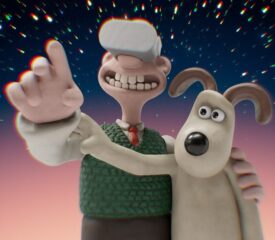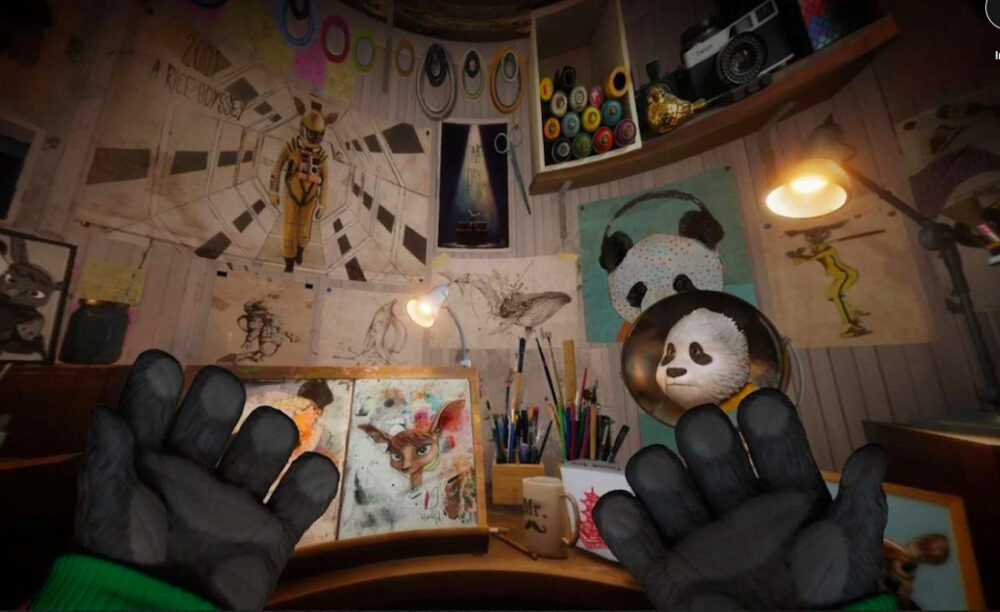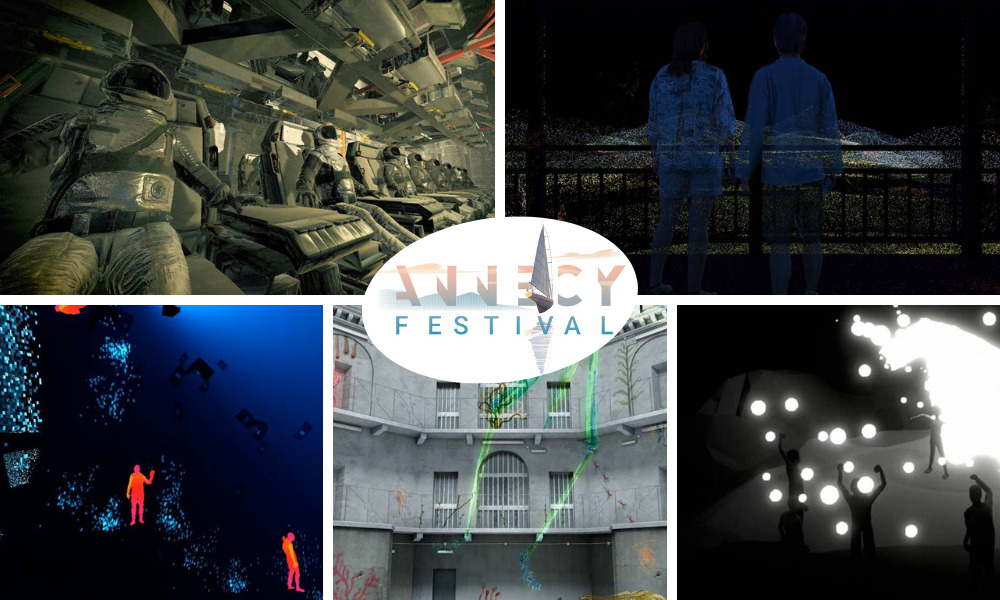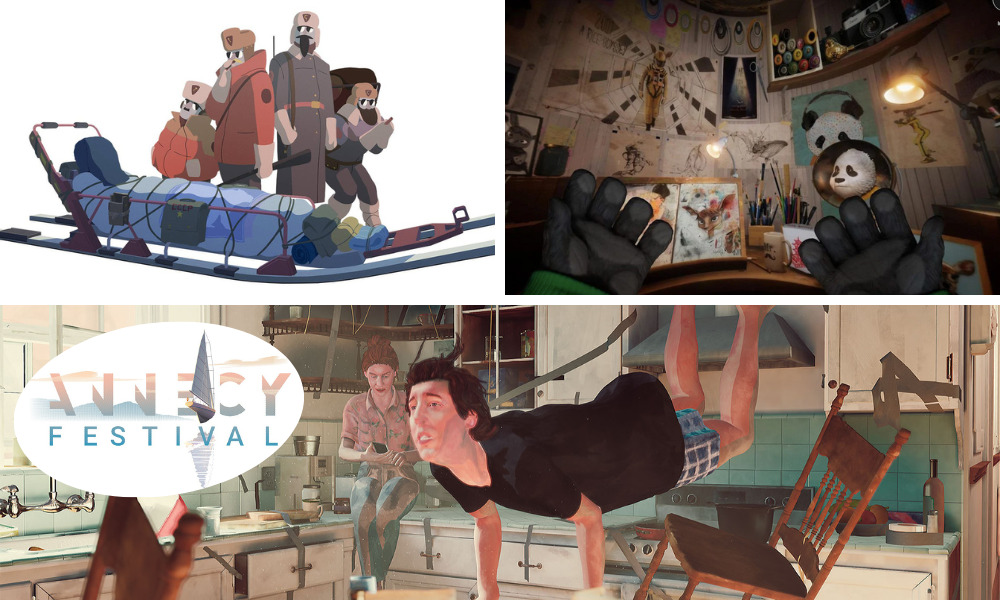***This article originally appeared in the 35th Anniversary Issue of Animation Magazine (June-July ’22, No. 321)***

The Annecy International Animation Film Festival has long strived to be forward looking — not only by highlighting ‘Works in Progress’ on upcoming feature films, but also by embracing emerging technologies like virtual reality.
This year, commercial VR will get a high-profile boost at Annecy when Aardman Animations’ famed Wallace & Gromit franchise unveils its VR bona fides with The Grand Getaway. Co-produced by Aardman and the virtual reality pros at Atlas V, the piece was funded by Meta to run on that company’s Quest 2 VR headsets. It may signal what VR productions could become when made with beloved characters… and big budgets.
But, Annecy’s VR selections this year also highlight production approaches that sit squarely in a more experimental realm. They have not been spun off of movies or game franchises, and their creators have both the desire — and often the necessity — to invent new characters designed specifically for presentation in VR.

Glimpse
Character animation still lies at the heart of many VR projects — especially those that tell relationship stories like Glimpse. This 23-minute animated experience follows an unusual love affair backwards in time. The anthropomorphized stars are a well-spoken bear and his deer girlfriend, and their conversations are voiced by actors Taron Egerton (Rocketman) and Lucy Boynton (Bohemian Rhapsody).
As VR viewers let their gaze wander around the intricate sets in Glimpse, the narrative unfolds through poignant dialogue. Co-directors Benjamin Cleary (who wrote the Oscar-winning short Stutterer) collaborated with experienced game creator Michael O’Connor to blend traditional story arcs with interactive design. As Glimpse producer Lee Harris observes, “Drawing people from different industries is required when constructing a VR experience. Many had some VR experience under their belts but originally came from more traditional media such as film, animation, games and VFX.”
Cleary and O’Connor oversaw Glimpse through their Dublin-based company Mr. Kite, and worked with the BAFTA-winning London studio Blue Zoo on the animation. “Blue Zoo had some experience with the Unreal Engine, which was very advantageous,” notes Harris. The Glimpse team customized Unreal for this project, creating unique workflows and pipelines as needed. “We also created a multiplayer-style layout tool, which enabled us to design and iterate quickly on virtual environments.”
The 3D character animation in Glimpse was created with Maya, and not motion capture. As Harris explains, “That allowed us to be more flexible in the types of performances we gave to the characters, depending on their scale and position within the 3D world. How things played out was dictated by the language of VR — the ‘physical’ space, the interactions, pacing, transitions and the environment itself.”
If it sounds like it took a lot of wrangling to align all the elements behind the project, it did. Harris’ company, Electric Skies, collaborated not only with Mr. Kite, Blue Zoo and Unreal, but also with Viveport, DN Pictures, Albyon and the BFI. Working with Viveport — where the VR experience of Glimpse is initially available — was key to the project. As Harris explains, “Having their support at an early stage helped us to springboard the entire production and allow us to raise financing. We’re also looking to bring it to other audiences on standalone headsets.”
In the end, the production country credits for Glimpse — France, U.K. and Ireland — reflect how indie VR production is often a global ‘pay as you go’ proposition. And festival exposure at Annecy is a vital step towards payback.

Marco & Polo Go Round
The creators of Marco & Polo Go Round describe their 12-minute VR experience as a love story with a surreal twist. While the viewers witness a young couple having an argument in their kitchen, things start falling apart around them — literally. Knives and plates and curtains fly around as the couple’s interactions unravel. As director Benjamin Steiger Levine explains, “I’ve always been drawn to stories that transport audiences to dreamed realities.” Levine, who also co-wrote the script, recalls, “When I first experienced VR, I instantly knew it was the right medium for Marco & Polo Go Round. I wanted the emotional and visceral experience of the story to be lived.”
The actors who play Marco (Emmanuel Schwartz) and Polo (Léane Labrèche-Dor) brought extensive acting experience to performing Levine’s dialogue. Translating their movements into VR was the challenge that faced the motion-capture experts at Studio du Château in Montreal, Canada.
For the mo-cap sessions, they used basic suits that had sensors connected to a wi-fi hub, explains Levine. “I found directing motion capture to be an extremely ‘pure’ experience. There’s nothing to tell you whether a scene is working except the emotional truth the actors bring to the moment. Sometimes I closed my eyes and just listened. Subtle inflections in how they delivered their lines became the best indicators of which takes were working.”
On a technical level, choreographing the entire sequence without any actual swirling objects required extreme planning. The actors were able to handle some objects on a physically built set, and blocking was worked out meticulously. Facial capture was recorded simply with an iPhone. Levine credits Hugues Bruyère of Montreal’s Dpt. for building the innovative structure of Glimpse, as well as overseeing the photogrammetry of the actors and pipeline issues.
Positioning all this data became trickier when the swirling objects had to be simulated in CG. Dpt.’s Sam Walker managed most of the simulations, overseeing how objects floated around the characters. The CG animation was created at Belgium’s Zest Studio, which is skilled with Maya, Houdini, Blender and Unreal, and has developed its own VR technology as well.
“All kinds of hacks and cheats were needed to get the sims from Houdini into Blender and then into Unreal,” recalls Levine. Programs that originated for game productions aren’t designed to handle long narrative scenes, so getting hundreds of pieces to sync on one uninterrupted timeline was tricky.
Like most indie VR production today, multiple supporting entities were involved, including Item 7, Belga Productions and Arte. Levine is hopeful that exposure at festivals worldwide will lead eventually to distribution in VR, though he admits it’s still expensive to optimize the experience for platforms like Quest 2. “As of now, to run Marco & Polo Go Round as a VR experience you need a good gaming computer.”

Kidnapped in Vostok
It’s a mark of virtual reality’s evolution that artists increasingly wish to tell unusual stories in this format. Kidnapped in Vostok by French director Jean Bouthors is a case in point. The 15-minute experience immerses viewers in a mysterious kidnapping plot in which they’re held hostage by Russians seeking top secret data.
While this storyline may seem sadly timely today, Kidnapped in Vostok actually is set in 1979. The Cold War is still hot, and Russian scientists working in Antarctica are using any means possible to achieve their goals. The viewer actually is a central figure in this tale, tied to a sled, at the mercy of these captors. We’re able to move only our head to take in this hostile world.
“Only our head movements allow us to communicate,” explains Bouthors. “We wanted to create a parallel between the situation of the spectator and the character that we play, which is why we decided not to use controllers.”
Bouthors, who co-wrote the project and contributed animation as well, oversaw the creation of the project at the company he co-founded, Les Astronautes, in Bourg-lès-Valence, France. The studio’s work has largely been in film, TV and new media and videogames. “Our team mainly comes from video games and animation,” he explains. “Although this project doesn’t involve gameplay, it seemed essential to have the experience of a game designer to finesse the interactivity.”
The choice was made not to use motion capture, and the characters present a highly graphic, streamlined appearance. “I come from traditional animation,” says Bouthors. “It’s also one of the specialties of the studio. This was a graphic choice, but also an economic one. Interactivity obliges us to plan many variants of the story, which requires additional work vis-à-vis a linear film. Real-time animation, where we calculate the images for each eye, is very resource intensive. We looked for a refined graphic design to simplify the animation to meet this constraint. Characters with gloves, glasses and beards avoid lots of problems in the animation.”
Sound cues also were essential to keeping the viewer fully oriented during Kidnapped in Vostok. “The sound on VR projects has a really important role,” asserts Bouthors. “Watching the film with headphones during production allowed us to work in binaural and thus have a very precise spatialization. It’s a great tool to catch the viewer’s attention and we play with it throughout the story.”
Kidnapped in Vostok was in primary production from 2019 through 2021, but the work actually continues with an eye towards the future. Bourthors’ team is working on an adaptation for a 3-DoF headset, and he’s said he hopes it can be seen eventually on economical platforms like Gear VR and Cardboard. “But it will obviously not be the same experience as it is in 6-DoF,” says Bouthors. “I will always recommend people see it in 6-DoF!”
For more information and complete schedule of programs at the Annecy Festival, visit annecy.org.

The Full Lineup
- Affiorare by Rossella Schillaci (Italy, Portugal)
- Déjà-vu by Dennis Stein-Schomburg (Germany)
- Glimpse by Benjamin Cleary & Michael O’Connor (France, Ireland, U.K.)
- Goliath: Playing with Reality by Barry Gene Murphy & May Abdalla (U.K., France)
- Kidnapped in Vostok by Jean Bouthors (France)
- Marco & Polo Go Round by Benjamin Steiger Levine (Belgium, Canada)
- On the Morning You Wake (To the End of the World) by Mike Brett, Steve Jamison, Pierre Zandrowicz & Arnaud Colinart (U.S., France, U.K.)
- Samsara by Hsin-Chien Huang (Taiwan)




 Win a Funko X Lilo & Stitch Prize Pack!
Win a Funko X Lilo & Stitch Prize Pack!

